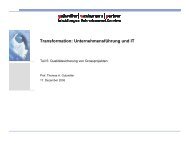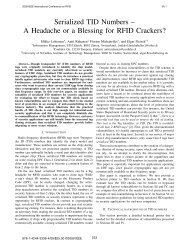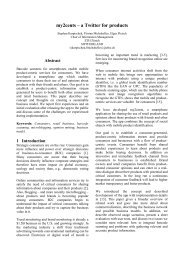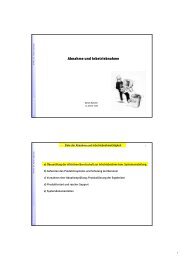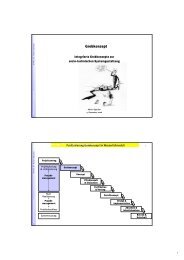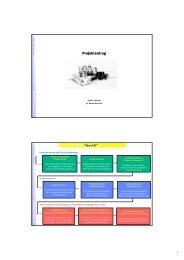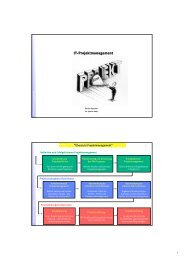An RFID Tag in Every Ski â Item-Level Tagging in the Ski Industry ...
An RFID Tag in Every Ski â Item-Level Tagging in the Ski Industry ...
An RFID Tag in Every Ski â Item-Level Tagging in the Ski Industry ...
Create successful ePaper yourself
Turn your PDF publications into a flip-book with our unique Google optimized e-Paper software.
<strong>An</strong> <strong>RFID</strong> <strong>Tag</strong> <strong>in</strong> <strong>Every</strong> <strong>Ski</strong> –<br />
<strong>Item</strong>-<strong>Level</strong> <strong>Tag</strong>g<strong>in</strong>g <strong>in</strong> <strong>the</strong> <strong>Ski</strong> <strong>Industry</strong><br />
Florian Michahelles, Christian Flörkemeier,<br />
Mikko Lehtonen, Steve H<strong>in</strong>ske ∗<br />
Abstract<br />
Radio-based identification has become common <strong>in</strong> a number of niche applications, such as car<br />
immobilizers and animal tagg<strong>in</strong>g. More recently, <strong>RFID</strong> has been considered as a promis<strong>in</strong>g technology<br />
to automatically identify <strong>in</strong>dividual products over <strong>the</strong>ir product lifecycle. In this paper, we<br />
provide a comprehensive overview of efforts with<strong>in</strong> <strong>the</strong> ski <strong>in</strong>dustry to equip each ski with a tag.<br />
Our analysis, which is based on a jo<strong>in</strong>t research program with <strong>the</strong> European ski <strong>in</strong>dustry, illustrates<br />
a number of different usage scenarios of a tag <strong>in</strong> <strong>the</strong> ski. These <strong>in</strong>clude rental, ma<strong>in</strong>tenance,<br />
<strong>the</strong>ft, and supply cha<strong>in</strong> applications. S<strong>in</strong>ce <strong>the</strong>re is no s<strong>in</strong>gle “killer” application that justifies <strong>the</strong><br />
use of <strong>the</strong> technology alone, <strong>the</strong>re is a need to choose a technical solution that supports at least<br />
a majority of <strong>the</strong> potential usage scenarios. In this paper, we illustrate that <strong>the</strong> development of<br />
a common technical solution based on standardized <strong>in</strong>terfaces is not straightforward due to <strong>the</strong><br />
partly conflict<strong>in</strong>g requirements and constra<strong>in</strong>ts.<br />
1. Introduction<br />
Radiofrequency identification (<strong>RFID</strong>) has appeared <strong>in</strong> a variety of applications where access control<br />
and robust data carriers without electrical contacts are required. Examples <strong>in</strong>clude keyless entry<br />
badges for build<strong>in</strong>g access [8] and ski ticket<strong>in</strong>g [9], car immobilizers [12], and animal tagg<strong>in</strong>g [7]. In<br />
<strong>the</strong>se application doma<strong>in</strong>s, <strong>the</strong> <strong>RFID</strong> system serves a s<strong>in</strong>gle, dedicated application, e.g., access to a<br />
build<strong>in</strong>g. The tags are attached to <strong>the</strong> same known object and <strong>the</strong>y also rema<strong>in</strong> with<strong>in</strong> <strong>the</strong> vic<strong>in</strong>ity of<br />
<strong>the</strong> deployed <strong>RFID</strong> <strong>in</strong>frastructure for <strong>the</strong>ir entire lifetime. The latter helps to build a solid return-on<strong>in</strong>vest<br />
for <strong>the</strong> use of <strong>the</strong> technology, while <strong>the</strong> known operational environment means that an <strong>RFID</strong><br />
system can be custom-built for a certa<strong>in</strong> scenario.<br />
More recently, <strong>RFID</strong> systems have been considered <strong>in</strong> novel application doma<strong>in</strong>s, where large numbers<br />
of <strong>in</strong>dividual products are tagged. Due to <strong>the</strong> lack of a predom<strong>in</strong>ant “killer” application that<br />
makes <strong>the</strong> use of <strong>RFID</strong> attractive for a s<strong>in</strong>gle application or product type alone, <strong>the</strong> adoption of <strong>RFID</strong><br />
for item-level tagg<strong>in</strong>g mandates that a number of applications benefit from <strong>the</strong> deployed <strong>RFID</strong> <strong>in</strong>frastructures.<br />
The result is that a variety of different products need to be tagged successfully and<br />
that <strong>the</strong> readers are distributed across different organizational boundaries. The latter means that <strong>the</strong><br />
entire <strong>RFID</strong> solution needs to be based on common standards, although <strong>the</strong> different applications and<br />
product characteristics impose conflict<strong>in</strong>g constra<strong>in</strong>ts and requirements.<br />
In this paper, we illustrate this challenge us<strong>in</strong>g <strong>the</strong> ski <strong>in</strong>dustry as an example. The <strong>in</strong>sights we<br />
present are <strong>the</strong> result of a jo<strong>in</strong>t research project with <strong>the</strong> European ski <strong>in</strong>dustry, where we analyze <strong>the</strong><br />
<strong>RFID</strong> application landscape <strong>in</strong> <strong>the</strong> ski <strong>in</strong>dustry and identify <strong>the</strong> requirements that a future <strong>in</strong>dustrywide<br />
adopted <strong>RFID</strong> solution has to meet. The contribution of this paper is two-fold. Based on<br />
<strong>in</strong>terviews with <strong>in</strong>dustry <strong>in</strong>siders, we provide a comprehensive overview of <strong>RFID</strong> applications <strong>in</strong> <strong>the</strong><br />
∗ ETH Zurich, Switzerland. fmichahelles@ethz.ch, floerkem@<strong>in</strong>f.ethz.ch, mikkol@ethz.ch, h<strong>in</strong>skes@<strong>in</strong>f.ethz.ch
ski <strong>in</strong>dustry. On <strong>the</strong> o<strong>the</strong>r hand, we also illustrate <strong>the</strong> partly conflict<strong>in</strong>g constra<strong>in</strong>ts imposed by each<br />
of <strong>the</strong>se applications and discuss <strong>the</strong> impact of different technical decisions. We believe that <strong>the</strong>se<br />
challenges that result from <strong>the</strong> lack of a s<strong>in</strong>gle application that absorbs <strong>the</strong> overall system costs are<br />
characteristic of item-level tagg<strong>in</strong>g efforts <strong>in</strong> o<strong>the</strong>r <strong>in</strong>dustries, e.g., automotive. The different technical<br />
trade-offs, discussed at <strong>the</strong> example of <strong>the</strong> ski <strong>in</strong>dustry <strong>in</strong> this paper, apply thus also to <strong>the</strong>se o<strong>the</strong>r<br />
item-level tagg<strong>in</strong>g efforts.<br />
This paper is organized as follows. In Section 2, we present <strong>the</strong> applications that benefit from a tag <strong>in</strong><br />
<strong>the</strong> ski. This <strong>in</strong>cludes exist<strong>in</strong>g applications, such as rental, but also novel applications doma<strong>in</strong>s, such<br />
as <strong>the</strong>ft detection, ma<strong>in</strong>tenance and supply cha<strong>in</strong> applications. In Section 3, we present <strong>the</strong> different<br />
levels at which standardization needs to occur and illustrate <strong>the</strong> different constra<strong>in</strong>ts that need to be<br />
addressed.<br />
2. Application landscape<br />
The use of <strong>RFID</strong> with<strong>in</strong> <strong>the</strong> ski <strong>in</strong>dustry is not new. <strong>RFID</strong>-enabled ski ticket<strong>in</strong>g has become common<br />
<strong>in</strong> ski resorts, s<strong>in</strong>ce it provides user convenience and reduces manual labour at <strong>the</strong> ski lifts. In this<br />
paper, we focus exclusively on applications of an <strong>RFID</strong> tag <strong>in</strong> <strong>the</strong> ski. The usage scenarios presented<br />
<strong>in</strong> this section are ei<strong>the</strong>r exist<strong>in</strong>g <strong>RFID</strong> applications that are already deployed on a small scale, such<br />
as <strong>the</strong> rental application, or novel application scenarios that are currently discussed with<strong>in</strong> <strong>the</strong> ski<br />
<strong>in</strong>dustry.<br />
2.1. Rental shop<br />
Today’s rental shops operate largely with bar codes that are attached to <strong>the</strong> product locally <strong>in</strong> <strong>the</strong> rental<br />
shop, when <strong>the</strong> new rental skis arrive at <strong>the</strong> beg<strong>in</strong>n<strong>in</strong>g of <strong>the</strong> season. The result is that product <strong>in</strong>formation,<br />
such as manufacturer, product type, length, and serial number, need to be entered manually<br />
<strong>in</strong>to <strong>the</strong> rental software that manages <strong>the</strong> rental process. <strong>An</strong> <strong>RFID</strong> tag <strong>in</strong> <strong>the</strong> ski elim<strong>in</strong>ates <strong>the</strong> need<br />
for this error-prone and labour <strong>in</strong>tensive process, s<strong>in</strong>ce <strong>the</strong> product data can ei<strong>the</strong>r be directly stored<br />
on <strong>the</strong> chip or alternatively retrieved from a backend <strong>in</strong>frastructure us<strong>in</strong>g <strong>the</strong> tag data as a reference.<br />
Staff at <strong>the</strong> rental shop simply scans <strong>the</strong> tag <strong>in</strong> <strong>the</strong> ski to add it to <strong>the</strong> virtual <strong>in</strong>ventory. This <strong>RFID</strong><br />
solution is currently deployed <strong>in</strong> a number of rental stores that operate <strong>in</strong> North America.<br />
The tag <strong>in</strong> <strong>the</strong> ski also helps when skis are rented out and returned. <strong>An</strong> employee uses a handheld<br />
<strong>RFID</strong> reader to identify <strong>the</strong> ski and to associate <strong>the</strong> ski with <strong>the</strong> customer. When <strong>the</strong> customer returns<br />
<strong>the</strong> skis, <strong>the</strong> ski is simply scanned aga<strong>in</strong> and <strong>the</strong> <strong>in</strong>ventory is updated. Accord<strong>in</strong>g to rental shop operators,<br />
this check-<strong>in</strong>/out process of rental equipment also works successfully with bar codes attached<br />
to <strong>the</strong> skis <strong>in</strong> <strong>the</strong> rental store and <strong>the</strong>re is little advantage <strong>in</strong> us<strong>in</strong>g an <strong>RFID</strong> tag due to <strong>the</strong> manual<br />
nature of <strong>the</strong> process. The failure of bar codes <strong>in</strong> harsh environments observed <strong>in</strong> o<strong>the</strong>r applications<br />
is thus not an issue here. It is <strong>in</strong>terest<strong>in</strong>g to note that source tagg<strong>in</strong>g of skis with bar codes by <strong>the</strong> ski<br />
manufacturer has not succeeded. <strong>Ski</strong> designer reject bar codes on (non-rental) skis because of <strong>the</strong>ir<br />
miss<strong>in</strong>g visual appeal. <strong>RFID</strong> tags with <strong>in</strong>creased read ranges would yet unlock new benefits for an<br />
<strong>RFID</strong> rental application. It would enable <strong>the</strong> rental shop software to automatically and cont<strong>in</strong>uously<br />
<strong>in</strong>ventory <strong>the</strong> rental skis placed <strong>in</strong> <strong>the</strong> racks.<br />
2.2. Theft prevention<br />
Theft of ski<strong>in</strong>g equipment is becom<strong>in</strong>g more frequent <strong>in</strong> ski resorts. Two start-up companies [6, 10]<br />
currently work on an <strong>RFID</strong> technology-based solution to counter <strong>the</strong> <strong>the</strong>ft of skis and snowboards.<br />
They propose to embed <strong>RFID</strong> tags <strong>in</strong>to skis dur<strong>in</strong>g <strong>the</strong> manufactur<strong>in</strong>g process <strong>in</strong> order to make <strong>the</strong>
emoval of <strong>RFID</strong> tags from stolen equipment unlikely. A network of <strong>RFID</strong> readers deployed at <strong>the</strong><br />
gates to <strong>the</strong> ski lifts will monitor <strong>the</strong> tags that pass by. If equipment gets stolen, <strong>the</strong> owner will report<br />
<strong>the</strong> <strong>the</strong>ft of <strong>the</strong> equipment and <strong>the</strong> tag IDs of <strong>the</strong> stolen skis are distributed to all <strong>RFID</strong> readers. The<br />
appearance of skis which are reported stolen at any monitored ski lift will <strong>the</strong>n raise an alarm. While<br />
this solution might not deter professional thieves, it is generally believed that this approach will reduce<br />
<strong>the</strong> likelihood of <strong>in</strong>surance fraud and <strong>the</strong> “opportunistic” <strong>the</strong>ft of ski<strong>in</strong>g equipment.<br />
2.3. Market<strong>in</strong>g<br />
The market<strong>in</strong>g department of <strong>the</strong> ski manufacturers lack today <strong>in</strong>formation on many details about <strong>the</strong><br />
product lifecycle. They have for example little <strong>in</strong>formation on <strong>the</strong> resorts <strong>the</strong>ir skis are used <strong>in</strong> and<br />
how often and for how long customers use <strong>the</strong> skis. Readers deployed across ski resorts to deter skier<br />
from us<strong>in</strong>g stolen skis could thus also ga<strong>the</strong>r data about <strong>the</strong> type of skis and usage patterns <strong>in</strong> different<br />
resorts.<br />
2.4. Ma<strong>in</strong>tenance support<br />
Throughout <strong>the</strong> lifecycle of a ski, an <strong>RFID</strong> tag might also be used to ma<strong>in</strong>ta<strong>in</strong> <strong>the</strong> ski more effectively<br />
accord<strong>in</strong>g to ski manufacturers. They believe that with <strong>the</strong> advent of ma<strong>in</strong>tenance equipment that<br />
adjusts its sett<strong>in</strong>gs to <strong>the</strong> characteristics of each ski, <strong>the</strong> tag <strong>in</strong> <strong>the</strong> ski can provide <strong>the</strong> correspond<strong>in</strong>g<br />
product data. This might <strong>in</strong>clude <strong>in</strong>formation on how to sharpen <strong>the</strong> ski edges and wax <strong>the</strong> base<br />
appropriately, given <strong>the</strong> characteristics of <strong>the</strong> ski. The tag <strong>in</strong> <strong>the</strong> ski can also be used to store b<strong>in</strong>d<strong>in</strong>g<br />
calibration data that need to be measured as part of <strong>the</strong> new ISO norm 11088 [1]. Fur<strong>the</strong>rmore, <strong>RFID</strong><br />
technology may be used to store records of <strong>the</strong> ma<strong>in</strong>tenance history of <strong>the</strong> ski <strong>in</strong> order to guarantee<br />
a more tailored treatment <strong>in</strong> <strong>the</strong> future. These ma<strong>in</strong>tenance applications requires <strong>the</strong> use of <strong>RFID</strong><br />
tag ma<strong>in</strong>ly because <strong>the</strong> <strong>in</strong>dustry-wide application of bar codes <strong>in</strong>to skis failed because <strong>the</strong> visual<br />
appearance of <strong>the</strong> bar code has a negative impact on <strong>the</strong> aes<strong>the</strong>tics of <strong>the</strong> ski.<br />
2.5. Supply-cha<strong>in</strong> management<br />
There are many similarities between supply-cha<strong>in</strong> management issues <strong>in</strong> <strong>the</strong> ski supply cha<strong>in</strong> and<br />
o<strong>the</strong>r <strong>in</strong>dustries, such as retail [5]. Common issues <strong>in</strong>clude shop floor out-of-stocks, automated receiv<strong>in</strong>g,<br />
and upstream replenishment. Out-of-stock is <strong>the</strong> most commonly cited improvement opportunity<br />
for retailers <strong>in</strong> <strong>the</strong> retail <strong>in</strong>dustry. <strong>RFID</strong> at <strong>the</strong> store-level can help to monitor, prevent, and to<br />
respond to <strong>in</strong>cidents of shelf-level out-of-stock. This is desirable <strong>in</strong> particular when product display<br />
density is high, staff<strong>in</strong>g levels are low and handl<strong>in</strong>g/mishandl<strong>in</strong>g of merchandise is frequent. <strong>RFID</strong><br />
can be fur<strong>the</strong>r used to establish automated receiv<strong>in</strong>g. <strong>Item</strong>-level tagg<strong>in</strong>g has <strong>the</strong> potential to <strong>in</strong>crease<br />
<strong>the</strong> accuracy of deliveries to stores and to streaml<strong>in</strong>e <strong>in</strong>bound receiv<strong>in</strong>g processes at <strong>the</strong> ski shop.<br />
This is <strong>in</strong> particular true for <strong>the</strong> ski <strong>in</strong>dustry because shipments are highly customized and thus errorprone.<br />
The benefit of <strong>RFID</strong> would be to elim<strong>in</strong>ate <strong>in</strong>voice disputes between retailer and manufacturer.<br />
Especially for seasonal items, such as skis, data captured by <strong>RFID</strong> could help to drive upstream replenishment.<br />
Product shortages could be detected earlier. In <strong>the</strong> long-term, this data can be used to<br />
better understand customer demand for future forecast<strong>in</strong>g based on real-term data <strong>in</strong>stead of out-dated<br />
data from <strong>the</strong> past.<br />
Mov<strong>in</strong>g up <strong>the</strong> supply-cha<strong>in</strong>, <strong>the</strong> manufacturers may use <strong>RFID</strong> to measure <strong>in</strong>-house performance and<br />
accuracy <strong>in</strong> real-time for cost-effective performance and quality management [11]. <strong>RFID</strong> <strong>in</strong>troduced<br />
on a larger scale can help ski manufacturers to more closely monitor outbound product flow and carrier<br />
performance. Fur<strong>the</strong>rmore, <strong>RFID</strong> can reveal post-shipment diversion to unauthorized sales channels.
Thus, <strong>RFID</strong> could provide aid to identify sales policy violators, such as off-price or unauthorized<br />
dealers.<br />
3. Need for standardized <strong>in</strong>terfaces<br />
While <strong>RFID</strong> is offer<strong>in</strong>g a variety of opportunities for <strong>the</strong> ski <strong>in</strong>dustry, <strong>the</strong> previous section showed<br />
that <strong>the</strong>re is no s<strong>in</strong>gle “killer” application that can absorb <strong>the</strong> costs of an <strong>RFID</strong> tag <strong>in</strong> every ski and<br />
<strong>the</strong> associated <strong>in</strong>vestments <strong>in</strong> a reader <strong>in</strong>frastructure. The challenge is ra<strong>the</strong>r to def<strong>in</strong>e a feasible<br />
technical solution that enables <strong>the</strong> majority of <strong>the</strong> above applications at appropriate costs. To provide<br />
<strong>in</strong>teroperability among <strong>the</strong>se different applications, <strong>the</strong>re is a need to agree on standardized <strong>in</strong>terfaces.<br />
This <strong>in</strong>cludes not only a standardized communication protocol between <strong>RFID</strong> readers and tags, but<br />
also common number<strong>in</strong>g and data formats. In this section, we discuss <strong>the</strong>se different <strong>in</strong>terfaces and<br />
present <strong>the</strong> different options that are available to <strong>the</strong> ski <strong>in</strong>dustry. We focus <strong>in</strong> particular on <strong>the</strong> tradeoffs<br />
that make <strong>the</strong> choice of appropriate standards non-trivial.<br />
To ensure that multiple applications can benefit from <strong>the</strong> tag <strong>in</strong> <strong>the</strong> ski, standardization needs to occur<br />
at <strong>the</strong> follow<strong>in</strong>g four different levels listed below:<br />
Communication protocol between <strong>RFID</strong> readers and tags There are a wide variety of communication<br />
protocols that govern <strong>the</strong> data exchange between <strong>RFID</strong> readers and tags. These differ<br />
<strong>in</strong> <strong>the</strong> operat<strong>in</strong>g frequency, cod<strong>in</strong>g, modulation, tim<strong>in</strong>gs, anti-collision algorithms, and <strong>the</strong> supported<br />
command sets. The choice of an appropriate protocol depends on <strong>the</strong> desired read range,<br />
data transfer speed, rate at which large tag populations can be identified, and form factors of<br />
tags and readers. The different communication protocols also <strong>in</strong>fluence cost of <strong>the</strong> tags and<br />
<strong>the</strong> susceptibility to <strong>in</strong>terference, e.g., from metal objects nearby. The metal pieces commonly<br />
built <strong>in</strong>to skis to improve <strong>the</strong>ir material properties favour <strong>RFID</strong> protocols that operate at low<br />
frequency (LF). Compatibility with item tagg<strong>in</strong>g efforts <strong>in</strong> <strong>the</strong> retail and pharmaceutical <strong>in</strong>dustries<br />
requires <strong>the</strong> use of protocols such as ISO 15693 [2] or 18000-6 [3] that operate <strong>in</strong> <strong>the</strong> HF<br />
and UHF frequency band, respectively. The latter is not suitable for operation outdoors because<br />
snow between readers and tag will make <strong>the</strong> radio-based identification impossible. The <strong>in</strong>tegration<br />
of HF tags <strong>in</strong>to <strong>the</strong> base of <strong>the</strong> ski mandates changes to <strong>the</strong> ski design to provide a small<br />
metal free zone. The choice of an appropriate protocol thus presents a significant challenge to<br />
<strong>the</strong> ski <strong>in</strong>dustry because <strong>the</strong>y effectively have to choose between <strong>the</strong> technology that requires<br />
<strong>the</strong> smallest number of modifications to <strong>the</strong> skis (LF) and <strong>the</strong> one that is compatible with tagg<strong>in</strong>g<br />
efforts <strong>in</strong> <strong>the</strong> retail <strong>in</strong>dustry (HF or UHF). The adoption of <strong>the</strong> latter might also decrease<br />
<strong>the</strong> cost of <strong>RFID</strong> tags and readers <strong>in</strong> <strong>the</strong> long term, as <strong>the</strong> economies of scale can help to reduce<br />
system cost.<br />
Product/tag identifier To fur<strong>the</strong>r guarantee <strong>in</strong>teroperability, <strong>the</strong> identifier stored on each tag needs to<br />
be standardized as well. This identifier can be a unique serial number that identifies <strong>the</strong> tag, but<br />
conta<strong>in</strong>s no <strong>in</strong>formation about <strong>the</strong> tagged product. Alternatively, an identifier code can be used<br />
to uniquely label <strong>the</strong> tagged product. Such an identifier code conta<strong>in</strong>s additional <strong>in</strong>formation<br />
about <strong>the</strong> tagged product, e.g., manufacturer and product type. The Electronic Product Code<br />
(EPC) [4] is <strong>the</strong> most common example of such an identifier code. A common number<strong>in</strong>g<br />
scheme for <strong>the</strong> tag/product identifier means that, even if <strong>the</strong> communication protocols between<br />
<strong>RFID</strong> readers and tags are not harmonized because of <strong>the</strong> challenges mentioned above, <strong>the</strong>re is<br />
at least <strong>in</strong>teroperability at <strong>the</strong> application layer. The ski <strong>in</strong>dustry could opt for an identifier code<br />
that is not compatible with exist<strong>in</strong>g number<strong>in</strong>g schemes, but is specifically designed to identify
skis. This would result <strong>in</strong> a m<strong>in</strong>imum memory footpr<strong>in</strong>t – possibly important to keep chip cost<br />
at a m<strong>in</strong>imum – but <strong>the</strong> result is that <strong>the</strong> solution is no longer compatible with <strong>the</strong> number<strong>in</strong>g<br />
formats used <strong>in</strong> o<strong>the</strong>r <strong>in</strong>dustries, such as retail, without additional translation.<br />
<strong>Tag</strong> position <strong>in</strong> <strong>the</strong> ski To facilitate <strong>the</strong> identification of <strong>the</strong> tag, <strong>the</strong>re is a need to standardize <strong>the</strong><br />
placement of <strong>the</strong> tag with<strong>in</strong> <strong>the</strong> ski. Common choices <strong>in</strong>clude <strong>the</strong> <strong>in</strong>tegration of <strong>the</strong> chip directly<br />
<strong>in</strong> <strong>the</strong> ski, e.g., <strong>in</strong> <strong>the</strong> tip or just above <strong>the</strong> b<strong>in</strong>d<strong>in</strong>g. Alternatively, <strong>the</strong> tag can also be <strong>in</strong>tegrated<br />
<strong>in</strong>to <strong>the</strong> b<strong>in</strong>d<strong>in</strong>g of one or both skis. The anti-<strong>the</strong>ft application mentioned above requires that<br />
<strong>the</strong> <strong>RFID</strong> tags are <strong>in</strong>tegrated <strong>in</strong>to <strong>the</strong> ski. O<strong>the</strong>rwise, <strong>the</strong> <strong>RFID</strong> tags could simply be removed<br />
on stolen skis. The best position of <strong>the</strong> tag <strong>in</strong> <strong>the</strong> ski depends also on <strong>the</strong> stresses <strong>the</strong> tag has to<br />
susta<strong>in</strong> <strong>in</strong> <strong>the</strong> various possible locations.<br />
Product data exchange The previous section showed that applications <strong>in</strong> rental and ma<strong>in</strong>tenance<br />
rely on product data, such as ski manufacturer, product name, and ski length. The <strong>RFID</strong> tag can<br />
provide <strong>the</strong>se data ei<strong>the</strong>r directly, if <strong>the</strong> data are stored on <strong>the</strong> tag, or <strong>in</strong>directly, if <strong>the</strong> tag/product<br />
identifier stored on <strong>the</strong> tag is used to look-up <strong>the</strong> appropriate product data <strong>in</strong> a product data<br />
catalogue. For trad<strong>in</strong>g partner to exchange product data, <strong>the</strong>y must have prior agreement as to<br />
<strong>the</strong> structure and mean<strong>in</strong>g of data to be exchanged, and <strong>the</strong> mechanisms by which exchange<br />
will be carried out. This applies to data storage on <strong>the</strong> tags as well as tags used as po<strong>in</strong>ters to<br />
entries <strong>in</strong> a background <strong>in</strong>frastructure. The latter necessitates <strong>the</strong> agreement on <strong>the</strong> appropriate<br />
transport protocols and au<strong>the</strong>ntication mechanisms. This means that <strong>the</strong> ski <strong>in</strong>dustry needs to<br />
beg<strong>in</strong> def<strong>in</strong><strong>in</strong>g common product data schemas that allow <strong>the</strong>m to accurately convey <strong>the</strong> product<br />
<strong>in</strong>formation to <strong>the</strong>ir supply cha<strong>in</strong> partners.<br />
4. Conclusions<br />
In this paper, we outl<strong>in</strong>ed that <strong>the</strong>re are a variety of applications that could benefit from <strong>RFID</strong> tags<br />
<strong>in</strong> skis. Never<strong>the</strong>less, <strong>the</strong>re is currently no s<strong>in</strong>gle killer application absorb<strong>in</strong>g <strong>the</strong> costs of putt<strong>in</strong>g a<br />
tag <strong>in</strong> each of <strong>the</strong> approximately four million skis produced annually. Thus, <strong>the</strong> ma<strong>in</strong> challenge for<br />
<strong>the</strong> ski <strong>in</strong>dustry will be to develop an <strong>RFID</strong> platform that allows for a majority of <strong>the</strong> aforementioned<br />
applications to benefit from <strong>the</strong> tags <strong>in</strong> <strong>the</strong> skis at affordable costs. The o<strong>the</strong>r challenge will be to<br />
create <strong>in</strong>terwoven bus<strong>in</strong>ess models and to set up partner alliances <strong>in</strong> order to drive this development<br />
as a jo<strong>in</strong>ed effort of <strong>the</strong> entire ski<strong>in</strong>g <strong>in</strong>dustry. From an operational perspective, work with<strong>in</strong> <strong>the</strong> ski<br />
<strong>in</strong>dustry on an appropriate migration path needs to cont<strong>in</strong>ue. Focuss<strong>in</strong>g on selected applications first,<br />
such as ski rental, could help to test <strong>the</strong> <strong>RFID</strong> platform before a full roll-out. In this step readers are<br />
only required <strong>in</strong> selected rental shops without <strong>the</strong> need of an established network. As <strong>the</strong> developed<br />
technical solution matures, <strong>the</strong> ma<strong>in</strong>tenance scenario may be added. Later, <strong>the</strong> payback achieved from<br />
rental and ma<strong>in</strong>tenance can fund <strong>the</strong> deployment of readers for <strong>the</strong>ft prevention. Once a significant<br />
number readers have been set up <strong>in</strong> <strong>the</strong> ma<strong>in</strong> ski resorts also <strong>the</strong> break-even for sell<strong>in</strong>g mean<strong>in</strong>gful<br />
market<strong>in</strong>g data may be reached.<br />
In order to ensure <strong>in</strong>teroperability among <strong>the</strong>se different applications <strong>in</strong> a cost efficient manner <strong>the</strong>re<br />
is a need to agree on standardized <strong>in</strong>terfaces and to focus on <strong>the</strong> ”core” features that are essential<br />
for <strong>the</strong> <strong>in</strong>dustry. The discussion <strong>in</strong> this paper illustrates that <strong>the</strong> decision which standards to adopt is<br />
not as straightforward as one might <strong>in</strong>itially th<strong>in</strong>k. Our analysis illustrates that <strong>the</strong> ski <strong>in</strong>dustry needs<br />
to answer a number of difficult questions before <strong>the</strong>y can move forward. The ski manufacturers for<br />
example have to decide whe<strong>the</strong>r <strong>the</strong>y are prepared to alter exist<strong>in</strong>g ski designs to improve <strong>RFID</strong> read<br />
rates at HF. They also need to discuss <strong>the</strong> importance of choos<strong>in</strong>g a communication protocol that is
compatible with one of <strong>the</strong> protocols that are currently considered for item-level tagg<strong>in</strong>g <strong>in</strong> <strong>the</strong> retail<br />
<strong>in</strong>dustry. Given <strong>the</strong> uncerta<strong>in</strong>ty about <strong>the</strong> appropriate communication protocol for item-level tagg<strong>in</strong>g<br />
<strong>in</strong> <strong>the</strong> retail <strong>in</strong>dustry (HF or UHF), this decision will rema<strong>in</strong> difficult <strong>in</strong> <strong>the</strong> short-term. Although <strong>the</strong><br />
<strong>in</strong>dustry has already carried out numerous tests, <strong>the</strong> outcome of <strong>the</strong>se tests have to be consolidated to<br />
f<strong>in</strong>d <strong>the</strong> best place to put <strong>the</strong> tag <strong>in</strong> <strong>the</strong> ski. The <strong>in</strong>dustry has to cont<strong>in</strong>ue with tests and identify its<br />
own needs, but simultaneously has to be ready to adopt emerg<strong>in</strong>g standards from related <strong>in</strong>dustries,<br />
such as retail. The <strong>in</strong>dustry also needs to decide whe<strong>the</strong>r possible privacy concerns, justified or vastly<br />
exaggerated, can have an negative <strong>in</strong>fluence on <strong>the</strong>ir brands. A prelim<strong>in</strong>ary analysis <strong>in</strong>dicates that <strong>the</strong><br />
high-tech nature of skis <strong>in</strong> general and <strong>the</strong> fact that we do not carry <strong>the</strong>m around with us <strong>in</strong> our daily<br />
lives limits <strong>the</strong> possible privacy concerns of <strong>the</strong> <strong>in</strong>dividual skier.<br />
These very challenges of def<strong>in</strong><strong>in</strong>g standards, creat<strong>in</strong>g partner alliances, f<strong>in</strong>d<strong>in</strong>g migration pa<strong>the</strong>s, mapp<strong>in</strong>g<br />
specific requirements to technical solutions at reasonable costs are witnessed <strong>in</strong> o<strong>the</strong>r <strong>in</strong>dustry<br />
sectors as well. Some, such as <strong>the</strong> retail <strong>in</strong>dustry, may be a step ahead because <strong>the</strong> roll-out of standardized<br />
<strong>RFID</strong> solutions has already begun. O<strong>the</strong>r <strong>in</strong>dustries, such as <strong>the</strong> pharmaceutical, aerospace,<br />
and automotive <strong>in</strong>dustry are at <strong>the</strong> same stage as <strong>the</strong> ski <strong>in</strong>dustry, where <strong>in</strong>dividual niche solutions of<br />
<strong>RFID</strong> need to be replaced by a harmonized <strong>RFID</strong> framework that scales.<br />
References<br />
[1] ISO: International Standard ISO 11088, Assembly, adjustment and <strong>in</strong>spection of an alp<strong>in</strong>e<br />
ski/b<strong>in</strong>d<strong>in</strong>g/boot (S-B-B) system, 2004.<br />
[2] ISO: International Standard ISO 15693, Identification cards - contactless <strong>in</strong>tegrated circuit cards<br />
- Vic<strong>in</strong>ity Cards, 2001.<br />
[3] ISO: International Standard ISO 18000-6, <strong>RFID</strong> for item management - Air <strong>in</strong>terface, Part 6,<br />
2004.<br />
[4] D. L. Brock. The Electronic Product Code A Nam<strong>in</strong>g Scheme for Physical Objects. Technical<br />
report, MIT Auto-ID Center, 2002.<br />
[5] Gav<strong>in</strong> Chappell, David Durdan, Greg Gilbert, Lyle G<strong>in</strong>sburg, Jeff Smith, and Joseph Tobolski.<br />
Auto-ID on Delivery: The Value of Auto- Technology <strong>in</strong> <strong>the</strong> Retail Supply Cha<strong>in</strong>. Technical<br />
report, Auto-ID Center, MIT, 2002.<br />
[6] EC-Passage, 2006. http://www.ec-passage.com.<br />
[7] R. Geers, B. Puers, and P. Wouter. Electronic Identification, Monitor<strong>in</strong>g and Track<strong>in</strong>g of <strong>An</strong>imals.<br />
CAB International, Wall<strong>in</strong>gford, 1997.<br />
[8] Dieter Koch and Peter Gahr. Elektronische Schliesssysteme. Baumeister - Zeitschrift für Architektur,<br />
3, 1998.<br />
[9] <strong>Ski</strong>Data, 2006. http://www.skidata.com.<br />
[10] <strong>Ski</strong>Guard, 2006. http://www.skiguard.at.<br />
[11] Christian Tellkamp, Alfred <strong>An</strong>gerer, Elgar Fleisch, and Daniel Corsten. From Pallet to Shelf:<br />
Improv<strong>in</strong>g Data Quality <strong>in</strong> Retail Supply Cha<strong>in</strong>s us<strong>in</strong>g <strong>RFID</strong>. Cutter IT Journal, 17/9, 2004.<br />
[12] Harthmut Wolf. Optimaler Kfz-Diebstahlschutz durch elektronische Wegfahrsperren. Technical<br />
Report No. 13, GME, vde-Verlag, Berl<strong>in</strong>, 1994.



